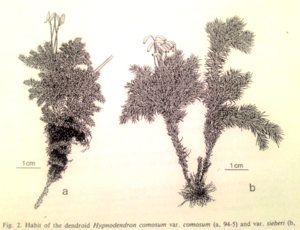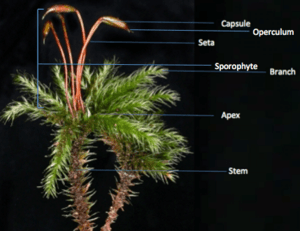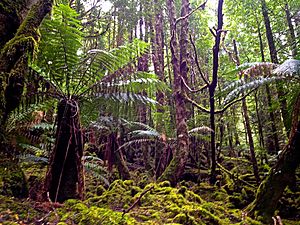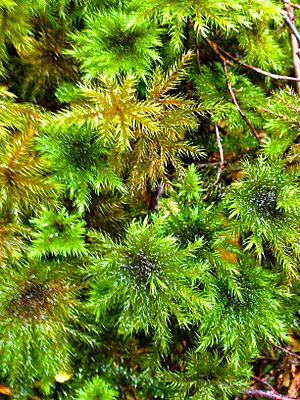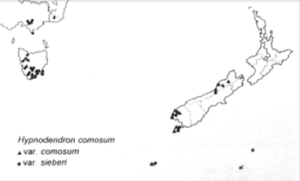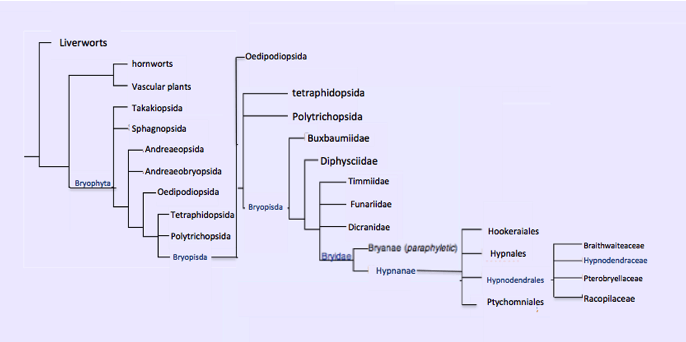Palm moss facts for kids
Quick facts for kids Palm moss |
|
|---|---|
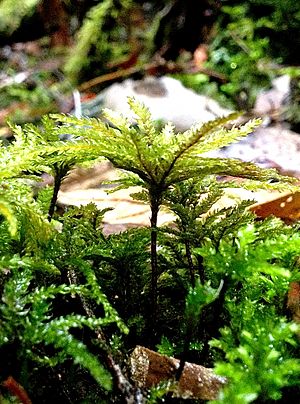 |
|
| Scientific classification | |
| Genus: |
Hypnodendron
|
| Species: |
comosum
|
| Varieties | |
|
Hypnodendron comosum var. comosum |
|
Hypnodendron comosum, often called palm moss or palm tree moss, is a type of moss that grows on the ground. It has two main kinds, or varieties: Hypnodendron comosum var. comosum and Hypnodendron comosum var. sieberi. Both kinds of Hypnodendron moss usually grow in wet places. You can find them in the temperate and tropical rainforests of New South Wales, Victoria, and Tasmania in southern Australia. They also grow in New Zealand.
This moss looks like a tiny forest of trees. Experts like David Meagher and Bruce Fuhrer say it's one of the most beautiful and special mosses in southern Australia. The two varieties look very similar. However, you can easily tell them apart because they stand taller than other mosses and lichens around them. The moss has a straight stem, and its branches at the top spread out like an umbrella. This is why it's called "palm tree moss."
Contents
What Does Palm Moss Look Like?
Both types of palm moss look very much alike and share many features. Their stems are long and thin, like a tree trunk. They grow between 2–9 cm (about 1–3.5 inches) tall. The stems are black or brown and have tiny hairs and small leaves. At the top of the stem, there's a green, umbrella-shaped group of fronds.
These fronds spread out horizontally and can be up to 5 cm (about 2 inches) wide. Each frond has many small branches, each 2–5 mm (about 0.1–0.2 inches) long. This makes the umbrella shape look clumpy, like a tiny palm tree. The leaves on the branches are triangular and yellowish-green. The middle vein (called the costa) is green or brown. The edges of the leaves are jagged near the tip.
The part of the moss that makes spores (called the sporophyte) grows from the center of the female plant. It forms a long stalk (called a seta) with a capsule at the end. H. comosum can have 4 to 12 of these sporophytes. The seta is long and thin, 2–4 cm (about 1–1.5 inches) long. The capsule is orange or brown and about 2–5 mm (0.1–0.2 inches) long. It's shaped like a cylinder.
The cap that covers the spores is called the operculum. Once it falls off, the spores are released. Even though both types of moss are similar, Hypnodendron comosum var. comosum is smaller and more compact. It's usually found in Tasmania. Its branches are packed closely together, making it look very dense. Hypnodendron comosum var. sieberi is found on mainland Australia. It's taller, and its branches are spread out more loosely.
How Palm Moss Works
Like all bryophytes (a group of simple plants that includes mosses), Hypnodendron species are non-vascular. This means they don't have special tubes or ducts inside them to carry water, nutrients, and sugars around, like bigger plants do. Bryophytes also don't have true roots. Instead, they have tiny root-like structures called rhizoids that help them stick to surfaces. Unlike plants with roots that take in gas, nutrients, and water from the soil, mosses can take these things in directly through their leaf surfaces. This lets them get what they need right where it's used.
Where Does Palm Moss Live?
This plant is often found in wet forests and rainforests. It likes places with moist, rich soil. You'll most commonly see it on wet rocks, tree roots, the bottom of living trees, and tree ferns. It especially likes areas with lots of decaying logs and rotting plant matter.
When conditions are dry, this moss grows in small clumps. But when it's wet, H. comosum forms large, dense mats, like tiny forests. This shows that it prefers very wet places to grow.
Where Can You Find Palm Moss?
Hypnodendron comosum is native to the Australian states of New South Wales, Victoria, and Tasmania. It also lives in New Zealand, Stewart Island, and the Campbell Islands.
Since it's found in both New Zealand and Australia, scientists think this species existed before the supercontinent Gondwanaland broke apart. This suggests that palm moss might be one of the earliest plants to move from water to land. Studying it could help us understand how vascular plants (plants with tubes for water) evolved.
Hypnodendron comosum var. sieberi is more common on mainland Australia and the northern South Island of New Zealand. H. c. var. comosum is more often found in Tasmania, the southern South Island of New Zealand, and the islands in the southern ocean.
Palm Moss Family Tree
The Life Cycle of Palm Moss
Like all mosses, Hypnodendron comosum has an alternation of generations. This means its life cycle has two different stages or "generations." These are called the sporophyte stage and the gametophyte stage.
The gametophyte stage is when fertilization happens. It involves male and female parts called gametangia. In this stage, male sperm from the antheridium fertilizes the egg inside the archegonia. This creates a new cell called a zygote. This zygote then grows into the sporophyte.
The sporophyte stage is when spores are made. Once the zygote starts to grow, the seta (stalk) gets longer. A capsule, which holds the spores, forms at the end of the seta. This capsule has special tissue that makes spores. It also has a peristome to help release the spores and an operculum to protect them until they are ready.
Once the spores are released, they start to grow. They form a thin, root-like structure called a protonema. This protonema then develops buds. These buds grow into either a male or female gametophyte. The male gametophyte is called the antheridium, and the female is called the archegonium. This brings us back to the gametophyte stage, completing the cycle.


